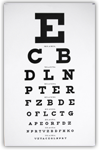Fuchs' Dystrophy
What is Fuchs' Dystrophy?
Fuchs' dystrophy is an uncommon, slowly progressive disorder that affects the cornea — the transparent front surface of your eye. Fuchs' dystrophy is a type of corneal dystrophy, a group of conditions that may cause a hazy deposit to build up over the cornea.
Normally, the endothelium prevent excess fluid from accumulating. This helps the cornea maintain its transparency. But with Fuchs' dystrophy, those endothelial cells slowly deteriorate, lose function and die. As a result, fluid builds up in the cornea. This may cause swelling, cloudy vision, pain and loss of corneal transparency.
Who is at Risk for Fuchs' Dystrophy?
For some who develop Fuchs' dystrophy, the cause is unknown. However, for many people it's inherited as an autosomal dominant familial condition, meaning that about half of an affected person's children also will have the disease. The extent to which relatives experience signs and symptoms may vary. For instance, a parent with a mild case and few symptoms could have a child with a severe case and numerous vision problems.
Some risk factors include:
- Women
- Someone with a family history of Fuchs' dystrophy
- People age 50 and older
What are the symptoms of Fuchs' Dystrophy?
Early signs of Fuchs' dystrophy may appear in people who are in their 30s and 40s, however, most people don't experience symptoms or problems until they're in their 50s and 60s.
Signs and symptoms usually affect both eyes and may include:
- Blurred vision on awakening that may gradually clear up as the day goes on
- Distorted vision
- Sensitivity to light
- Difficulty seeing at night and seeing halos around lights
- Generalized eye discomfort
- Painful, tiny blisters (epithelial blisters) on the surface of your cornea
- A cornea that appears cloudy or hazy
- Blindness
If you experience some of these symptoms, and especially if they get worse over time, see your eye doctor. If symptoms develop suddenly, call an ophthalmologist for an urgent appointment. Other eye conditions that cause the same symptoms as Fuchs' dystrophy also require prompt treatment.
How is Fuchs' Dystrophy detected?
You may go through testing so that your doctor can determine whether you have Fuchs' dystrophy.

Testing may include:
- Visual acuity - standard test used during routine eye exams to determine if your vision has worsened since your last visit. You'll be asked to read a chart with letters and numbers on it.
- Glare test - Similar to the vision acuity test, a bright light is directed at your eye while you read the characters on the chart. This test helps to determine if bright light reduces your ability to see.
- Grade or guttata stage - Your doctor examines the endothelial cells in your cornea using a slit lamp. If there are irregularities, called guttae, on the back surface of the cornea, you may have Fuchs' dystrophy. After this exam, your Fuchs' dystrophy may be assigned a "grade" or "stage" of zero through five. This number indicates the severity of dystrophy. A zero means there's no disease while a five means much of your cornea is affected.
- Corneal pressure test - After numbing drops are applied your doctor will touch your eye with a special instrument that measures pressure within the eye.
- Corneal thickness test - An ultrasound is used to determine the thickness of your cornea. A thick cornea could indicate swelling caused by excess fluid usually seen in people with moderately advanced Fuchs' dystrophy.
- Corneal cell count - A test to record the size and shape of your endothelial cells, also measuring the number of endothelial cells within a specific part of your cornea. A lower cell count usually correlates with advanced disease.
How is Fuchs' Dystrophy treated?
The following methods and procedures may help improve your comfort or stop your signs and symptoms of Fuchs' dystrophy from worsening:
- Eyedrops or ointments - can reduce the amount of fluid in your cornea
- Dry your eyes - using a hair dryer two or three times a day to evaporate excess fluid in the cornea and dry out blisters
- Wear soft contact lenses - can improve vision and reduce discomfort
- Corneal transplant - This surgical procedure replaces damaged cornea tissue with healthy tissue from a donor. There are many types of corneal procedures. Some procedures replace only a few thin layers of the cornea, while others replace the entire cornea. For Fuchs' dystrophy, an increasingly common procedure replaces only the deep layers of the cornea, including the endothelium. This is sometimes referred to as endothelial keratoplasty or posterior lamellar endothelial keratoplasty.
Corneal transplants are common and effective. However, you may have to wait a long time for donor tissue to become available. And some people develop problems following transplants, such as rejection of the new corneal tissue. The majority of people who have a successful transplant for Fuchs' dystrophy continue to be free of symptoms for years after the transplant.
